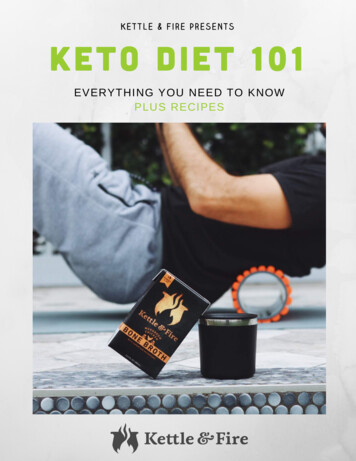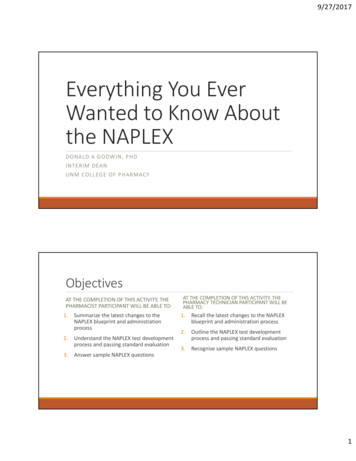
Transcription
EVERYTHING YOU NEED TO KNOWPLUS RECIPESKetoDiet101Everything You Need to KnowPlus Recipes!
Table ofContentsIntroduction1Chapter 1: Keto Diet Overview2Chapter 2: How the Keto Diet Works3Chapter 3: Types of Keto Diets4-5Chapter 4: Why You Should Follow a Keto Diet6-8Chapter 5: How to Follow a Keto Diet9-10Chapter 6: The Keto Diet Foods11-15Chapter 7: Three Big Mistakes to Avoid16-18Chapter 8: How to Test if You’re in Ketosis19-20Chapter 9: Potential Keto Side Effects21-30
Table ofContentsChapter 10: Top Keto Supplements and Functional Foods31-39Chapter 11: Benefits of Bone Broth on Keto40-45Chapter 12: Paleo vs. Keto46-49Chapter 13: Keto Recipes50-79References80-84
IntroductionWhat if you could train your body to burn fat more efficiently and speed up yourmetabolism without restricting calories? If you’re struggling to lose those last 5pounds or wondering why the muffin top just won’t budge (despite eating cleanand exercising), you may find the answers you’re looking for in this keto dietmaster guide.Keto diet 101 1
Chapter 1:Keto Diet OverviewSo what exactly is the ketogenic diet? The ketogenic (a.k.a: “keto”) diet is a high-fat, lowcarb diet that puts your body in a natural fat-burning metabolic state called ketosis (1). Theslogan: “eat fat to burn fat.”This is done by heavily restricting carbs and focusing on high-fat, moderate-protein meals.(However, in some cases, protein may be also be heavily restricted.) The classic ketogenicdiet contains a 4:1 ratio of fat to proteins and carbs.Now, the keto diet is often grouped with other high-fat, low-carb diets, such as the Paleo orAtkins diets. But the reason these diets boast fat-burning benefits in the first place is because they promote ketosis. Therefore, the ketogenic diet isn’t so much a “diet,” but ratherthe foundation of these diets, and the biochemical reaction that occurs when you train yourbody to burn fat for fuel instead of carbs.While the ketogenic diet has become popular for weight loss, studies also have shownnumerous other health benefits of following a keto diet. For example, a keto diet may helpreverse type 2 diabetes and reduce symptoms of Alzheimer’s disease, depression, andautism (2)(3). In fact, the keto diet was first used in the 1920’s as a natural treatment toprevent seizures in epilepsy patients (4) — not as a weight loss diet.Let’s look closer at how the ketogenic diet can work for dramatic weight loss, as well asother ways it can improve your health.Keto diet 101 2
Chapter 2:How The Keto Diet WorksAs we’ve covered, the purpose of the keto diet is to train your body to burn fat for fuel (rather than carbs)by remaining in a state of ketosis. In order for this to happen, you must remove the majority of carbs (inmost cases, 90 percent to 95 percent) from your diet.Why? By default, your body generates energy from carbohydrates (glucose), which are stored as glycogenin your muscle tissue and liver (5). You store enough carbs for approximately 24 hours worth of energy (5).Now, most of us easily replenish our carb stores by eating fruit, vegetables, grains, and legumes, so ourcarb “fuel tanks” rarely get low, and we continue burning glucose for energy.However, in the case you do run low on glucose, your body will switch gears and begin converting storedfatty acids to ketones, which can be used as a secondary energy source (6). This is why the ketogenic dietis so effective for losing weight. Instead of starving yourself, you’re training your body to burn fat for energy.Now, since carbs are your body’s first choice for energy and fat is secondary, the only way to get yourbody to burn fat for fuel instead of carbs is by getting your body into a “ketotic state,” usually by removingthe majority of carbs from your diet. Without stored glucose, your body has no choice but to dip into yourfat stores and begin converting those fatty acids to ketones when you need energy (7). Enough fat can bestored in the body to provide weeks (or even months!) worth of energy, which is why people can survivefasting (8). The amount of fat your body can utilize for energy will depend on your body composition andthe fat percentage you’re carrying.As you can see, keeping your body in ketosis for prolonged periods of time teaches your body to burn fatfor energy more efficiently, which is how the keto diet can reduce your overall fat mass without starving,since high-fat foods keep you full longer.However, the keto diet may not always trigger weight loss, especially if you already have a low body fatpercentage.But weight loss isn’t the only benefit or reason to follow a ketogenic diet. Let’s look at some of the otherbenefits.Keto diet 101 3
Chapter 3:Types Of Keto DietsThere are many different ways to follow a keto diet. Here are four of the most common ones:1. Standard Ketogenic Diet (SKD)This standard ketogenic diet is one of the most researched versions of the keto diet, andis what we’re primarily referring to throughout this article (although, the same principleswe’ve discussed apply to most of the other forms).The SKD generally includes a diet made up of 5% carbs, 20% protein, and 75% fat.2. Targeted Ketogenic Diet (TKD)The targeted ketogenic diet allows you to add extra carbs around workouts, surpassing theSKD 5% carb rule. This one may be a better option for those who are extremely active andtrain more than twice per week. The easiest way to see if this is working for you is to keeptesting your ketone levels when you add carbs after workouts and make sure that theydon’t kick you out of ketosis.Keto diet 101 4
3. Cyclical Ketogenic Diet (CKD)This form rotates ketogenic days with high carb days. It’s usually five ketogenic days, followed by two high carb days. Sometimes referred to as ketogenic carb cycling, this versionof the keto diet can help maximize fat loss and build muscle.On high carb days, your body will leave a state of ketosis. But these “carb refeeds” may bemore effective for muscle growth than the high-protein or targeted keto diet, since glycogen is the nutrient that “feeds” muscles (9). Ketogenic carb cycling is also said to be lessof a lifestyle stressor for some people, as the two high-carb days make the CKD feel lessrestrictive and easier to follow.Image courtesy: Perfect KetoKeto diet 101 5
Chapter 4:Why You Should Follow a Keto DietA Keto Diet Is Good for Heart HealthWait. Doesn’t fat raise LDL cholesterol and increase your risk for heart disease?If that were the case, surely the keto diet would be the perfect storm for a heart attack.However, studies have proven that fat is not the culprit in cardiovascular disease. In fact, tothis day, no reputable study has been able to show a link between saturated fat and cardiovascular disease (10).Instead, research shows diets high in refined sugar and carbs are far more destructive tothe heart and arteries than fat, and have a greater ability to raise blood pressure and promote inflammation (11).Since the keto diet removes all processed carbs and starchy carbs, it may serve as both apreventative and therapeutic diet for those at risk.A Keto Diet Helps Maintain Healthy Blood SugarIf you develop a condition related to blood sugar imbalance, such as type 2 diabetes, itmeans your body has stopped properly responding to insulin, the hormone that bringssugar out of your bloodstream and into your cells to be used and stored as energy (12).This is also known as insulin resistance.Keto diet 101 6
There’s good and bad news here: While type 2 diabetes is primarily caused by excessrefined sugar and carbs in your diet, it’s a condition that also can be reversed by changingthe foods you eat (13). Again, since the ketogenic diet removes most carbs, it gives yourbody a chance to reestablish and reset the communication with insulin, which can improveinsulin sensitivity and reverse blood sugar imbalances.Even when followed as a short-term solution, ketosis may help improve other blood sugarconditions, such as hyperglycemia and hypoglycemia. With the permission (and supervision) of a qualified healthcare practitioner, the keto diet also can be followed safely as along-term protocol for eliminating type 2 diabetes (14).A Keto Diet Can Improve Cognitive FunctionThe brain can only use two types of nutrients for fuel: glucose, and ketones (15). This iswhy — despite information that states a certain amount of glucose is needed per day foroptimal brain function — a keto diet can actually support cognitive function. In fact, somepeople report improved focus, concentration and mental alertness when they enter ketosis.The improved mental performance may be due to the fact that certain ketones, such asbeta hydroxybutyrate (BHB), produce more ATP (energy) than glucose, which would actually make fat a more efficient fuel source. However, there are few studies to back up thisclaim.As mentioned above, the keto diet also has been used effectively for preventing seizuresin epileptic patients, especially those who don’t respond well to medication. While it’s notentirely clear how this process works, research suggests removing carbs and mimickingthe effect of starvation may block the neuron channels that lead to the “electrical storm inthe brain” that results in a seizure (16).Additionally, the keto diet also may help patients with degenerative disorders, such as Alzheimer’s disease (17). Research shows that with the onset of Alzheimer’s, the brain’s cellsstop responding to insulin (much like type 2 diabetes), which causes inflammation in thebrain (18). By restricting carbs, the keto diet may help improve insulin sensitivity when itcomes to blood sugar and brain function.A Keto Diet Can Provide a Metabolism BoostSome studies suggest ketosis can increase your metabolism by causing even more calories to be expended during the fat-for-fuel burning process (26).Keto diet 101 7
A Keto Diet Can Improve Skin HealthA high-carb diet (especially when it comes to dairy products and refined sugar) has beenshown to trigger sebum (oil) production in the skin, which is a major cause of acne (19).Removing sugar from your diet also may help improve inflammatory skin conditions, suchas eczema and psoriasis (20). The healthy fats encouraged on the keto diet also providethe building blocks of healthy skin cells (21).A Keto Diet Can Help With Hormonal BalanceSince ketosis has the ability to improve how insulin functions, it may also improve the restof your hormones and correct hormonal imbalances, such as polycystic ovarian syndrome,or PCOS (22).An easy way to understand how your hormones work is to picture them as strands of aspider web: you can’t remove one strand without affecting the rest. In other words, whenone hormone is out of balance, the rest are negatively impacted. But when the functioningof one hormone is improved, the rest are improved, too.A Keto Diet Could Have Anticancer PropertiesCancerous tumorous use glucose as a main source of energy to grow (23). For this reason,a keto diet is recommended to slow tumor growth in cancer patients of all stages by starving the cells.Research shows the keto diet may also enhance a patient’s response to chemotherapy. Infact, one study reported an improvement in sleep and emotional functioning in patientsundergoing chemo who were also following a keto diet (24).A Keto Diet Can Help Control Food CravingsAnother way a keto diet can contribute to weight loss is by balancing your blood sugar levels, which reduces cravings for carbs (25). Since high-fat foods also are richer and moresatiating than carbs, they fill you up in smaller portions, further leading to weight loss.Keto diet 101 8
Chapter 5:How to Follow a Keto DietSince each person has a different body fat percentage and nutrient requirements, there isno one-size-fits-all caloric or macronutrient rule for getting into ketosis.For example, athletes who train four to five times per week will still be able to enter astate of ketosis by eating a higher percentage of carbs, compared to someone who’s mostly sedentary.The amount of carbs you’re allotted each day and the best type of keto diet for you to follow will depend on:Your current weightYour current body fat percentageYour heightYour genderYour fitness and activity levelsYour fitness and health goals (for example, body builders may experience more musclegain from a cyclical ketogenic diet vs. a standard keto diet)If you’re not already a keto pro, you can calculate your personal optimal macronutrientratios by using this ketogenic calculator.Keto diet 101 9
How Long Do I Have To Stay Keto For?There’s really no set rule for how long you have to stay on a ketogenic diet.Many keto proponents think of it as a tool for aiding weight loss or mental clarity. Many willdo a ketogenic diet for several weeks, then a Paleo diet for a few months, and back to aketogenic diet.However, if you’re using a ketogenic diet for therapeutic purposes, then you may need tostay on it for longer – that’s something to discuss with a health practitioner.Personalizing Your Ketogenic DietOne of the best things about a keto diet is that many people in the community love figuringthings out. There’s a lot of self-experimentation and sharing of data and ideas.Some people do better on a slightly higher fat ketogenic diet, while others can eat slightlymore carbohydrates. Intermittent fasting is also an area that many people on a ketogenicdiet experiment with.This is an exciting growing field that’s helping a lot of people, so if you’re ready to give it atry, keep an open mind and have fun improving your body and mind.Keto diet 101 10
Chapter 6:The Keto Diet FoodsMain Food Groups to Avoid on a Keto DietGrain:Fruit:Root Vegetables:Beans and Legumes:Unhealthy Fats:Processed Foods:Condiments:Alcohol:any type of whole grain or grain-based product (pasta,bread, cereal, rice, etc.)all fruit (a few blackberries or strawberries are the exception if you’re not at your total carb percentage for the day,since they’re lower in sugar)potatoes, sweet potatoes, parsnips, yams, carrotslentils, garbanzo beans, peanuts, peas, kidney beans, navybeansthe keto diet encourages healthy fats, not unhealthy fats,like those found in refined vegetable oils, including canola,soybean, sunflower, and peanut oilavoid anything in a package or box, because it will mostlikely contain either a grain, sugar alcohols (such as xylitol),refined sugar, or all of the abovesalad dressings, ketchup, and sauces are generally high incarbssince alcohol is a carbohydrate, even one glass of wine or abeer can throw you out of ketosisKeto diet 101 11
Main Food Groups to Eat on a Keto DietMeat:Fatty Fish:Poultry:Nuts and Seeds:Healthy Fats:Low Carb Vegetables:Herbs and Spices:beef, elk, bison, bacon, hamwild salmon, halibut, sardines, mackerelchicken, organic eggsalmonds, walnuts, macadamia nuts, cashews, flaxseeds,pumpkin seeds, chia seedsavocado, coconut oil, extra virgin olive oil, avocado oilleafy greens, onions, tomatoes, peppers, broccoli, asparagusturmeric, black pepper, basil, mint, parsley, cilantro, mustard seedHere’s a complete food list on what you should eat and should not eat on a keto diet.*Note: these percentages are based on the Standard Ketogenic Diet (SKD).Keto diet 101 12
Keto diet 101 13
Keto diet 101 14
Keto diet 101 15
Chapter 7:Three Big Mistakes To AvoidNow that you’re thriving on a ketogenic diet, there are still a few issues to watch out for inorder to get the most out of your diet.#1 Not Getting Enough Salts (sodium, potassium, and magnesium)While we typically get lots of sodium on a regular diet (because most processed foods contain high amounts of added sodium), most people find that when they go keto and cut outprocessed foods, they are actually low on sodium.You might not think of low sodium as a problem, but it usually results in fatigue and cravings, so make sure you get sufficient amounts.Potassium (like sodium) is often excreted more when you’re on a ketogenic diet, so it’s alsoimportant to make sure you replenish your potassium — especially if you’re active. Youcan add more potassium to your diet by eating spinach and avocados.Finally, magnesium is a mineral that many of us are deficient in to begin with. (Many people point to soil depletion as the potential reason for our widespread deficiency.) Sincemagnesium is so important for sleep and mood, as well as our muscles and generalwell-being, it’s also good to make sure you are getting enough.One good way to add in more of these minerals to your ketogenic diet is to drink somebone broth – it contains sodium, potassium, and magnesium.Keto diet 101 16
#2 Not Eating Enough GreensOne of the keys of a ketogenic diet is to eat fewer carbohydrates. Many people interpretthis to also mean avoiding all vegetables.Please don’t do that.It’s true that some vegetables, like onions or mushrooms, contain a fair amount of carbs,and you might want to generally limit them.However, for good gut health and to ensure you get plenty of vitamins and minerals, it’simportant to keep eating a lot of vegetables. There are many ways to get more veggies intoyour diet. Salads, sautes, and green smoothies are all easy and quick to make.#3 Not ExercisingExercise is one of the components of a healthy lifestyle that many of us skip when we’retrying a new diet. It can be mentally hard to stick to keto during the first few weeks, andthat makes going to the gym seem awful.However, it’s good to try to do some exercise if you can manage it. It’ll often help you getadapted to keto faster and help you lose fat (rather than muscle).Walking is one of the simplest options, but you can also do body weight exercises likepushups, situps, and squats at home.Who Should Not Follow The Keto DietA word of caution: if you’re starting a new dietary plan, especially if it’s for a condition ordisease, you need a professional to help you weigh your options.Pregnancy and breastfeeding are notable times of extreme physical vulnerability, andunless medically prescribed by a doctor, the ketogenic diet could do more harm than good.Likewise, certain conditions respond better to higher-carb and lower-protein diets (likecertain hormone imbalances or autoimmune diseases), so there’s still the matter of considering your individual circumstances above all else.Keto diet 101 17
Ketosis Vs. KetoacidosisKetosis is sometimes mixed up with the term ketoacidosis,which is a dangerous healthcondition that can turn your blood too acidic and lead to serious health problems, includingdeath (27).Ketoacidosis happens when your body fails to produce enough insulin (which is more commonly seen in those with type 1 diabetes), however it can also occur in those with type 2diabetes if their diet and insulin levels aren’t being properly monitored (28).When done properly, nutritional ketosis can improve insulin function, and people who don’thave blood sugar imbalances aren’t typically at risk for ketoacidosis (29).Image courtesy: Perfect KetoKeto diet 101 18
Chapter 8:How to Test if You Are in KetosisIn order for the keto diet to work, you’ll need to know if you’re in ketosis or not. There areseveral ways to measure ketones in your body, including through the blood, urine, andbreath. Here are the most common methods:1. Urine Testing StripsElevated levels of ketones (the acetoacetate group, to be specific) can be instantly detectedin your urine using strips, such as Perfect Keto and KetoStrips (only two of many brands).After dipping one of these strips into your urine stream, you’ll be able to find out whichstage of ketosis you’re in based on the color guide provided.You can find keto strips at nearly any drugstore, online through Amazon, or from PerfectKeto.2. Acetone Breath AnalyzerKetone breath analyzers allow you to measure the state of ketosis in your breath by detecting acetoacetates. A popular brand is Ketonix, which is a rechargeable ketone monitorthat can be used over and over again.(Also, a sign of ketosis is bad breath or “fruity” smelling breath, which you can detect onyour own!)Keto diet 101 19
3. Blood MonitorAccording to Authority Nutrition and many other online sources, the ketone blood monitoris the most accurate ketosis testing method. A blood monitor measures your state of ketosis by detecting the amount of beta-hydroxybutyrate (BHB) in your blood, which is one ofthe primary ketones.It is a little more invasive than the other keto testing methods, as it requires a prick ofblood from your finger.Test kits are around 40, and blood ketone test strips go for roughly 5 each (which you’llneed every time you test).Keto diet 101 20
Chapter 9:Potential Keto Side EffectsWhile a Keto diet is safe for most people in most situations, there are a couple of unfavorable side effects that could happen when you start a keto diet. They include the keto fluand the keto rash.The Keto FluThe keto flu can happen when you drastically and suddenly remove carbs from your diet.Also known as the “carb flu,” the keto flu is a natural reaction (almost like a feeling of withdrawal) your body undergoes when switching from burning glucose (sugar) as energy toburning fat instead. In fact, some people say the keto flu symptoms can actually feel similar to withdrawing from an addictive substance.If you decide to make the switch to the keto diet and you’re feeling drowsy, achy, nauseous,dizzy, and irritable, don’t worry. These symptoms are your body’s natural reaction to removing carbs from your diet. And while it may have you second guessing your keto dietdecision, we promise you these keto flu symptoms will pass. Stick with it, and soon you’llbe reaping the energizing, fat-burning rewards that come with ketosis.In the meantime, there are many things you can do to reduce the symptoms of the keto flu.We’ll tell you exactly which remedies you can start using today. But first, let’s take a quicklook at why the keto flu happens when you go low carb.Keto diet 101 21
Why The Keto Flu HappensBy default, your body burns glucose (carbs) as its primary energy source, but when youswitch to an extremely low-carb diet, your body will begin to burn fatty acids for energyinstead. Fat is your body’s secondary or “backup” fuel source, which can only be tappedwhen there’s not enough glucose in your diet. Symptoms of the Keto Flu are:Sugar cravingsDizzinessBrain fogIrritabilityPoor focus and concentrationStomach painsNauseaCrampingConfusionMuscle sorenessDifficulty falling asleepHow Long Does The Keto Flu Last?For the average person, the keto flu lasts a week or less, and symptoms usually beginwithin the first day or two of removing carbs. In extreme cases, the keto flu can last up to amonth, but that’s not as common.If you’re used to eating a diet high in refined sugar and processed foods, you’re more likelyto experience the withdrawal symptoms of removing carbs. In fact, studies show that sugar is more addictive than certain drugs (30).If your diet is relatively low in processed sugars and starches, you may only encountermild keto flu symptoms, or none at all.Not everyone experiences the keto flu, even when switching from diets high in carbs andsugar. Whether or not you experience the keto flu can depend on your genetics. Some people are naturally metabolically flexible, which means they can shift metabolic states easilywithout experiencing health symptoms.However, if you are experiencing the effects of the keto flu, here’s what you can do to reduce your symptoms (and how to prevent symptoms if you’re currently considering goinglow carb).Keto diet 101 22
How to Manage Keto Flu Symptoms1. Take an Electrolyte SupplementWhen you switch to an extremely low-carb ketogenic diet, you end up cutting out some ofthe richest natural sources of electrolytes, such as starchy fruit and vegetables.Not getting enough electrolytes in your diet can lead to fatigue, irritability, dizziness, muscle cramping, and cognitive symptoms, such as confusion (31)(32). In other words, lowelectrolytes play a big role in the onset of keto flu symptoms.One way to get more electrolytes in your diet without kicking your body out of ketosis isto take an electrolyte supplement at least once per day. If you’re active, you’ll also wantto make sure you’re taking electrolytes after you workout to prevent muscle cramps anddehydration.Of course, if you’re following the keto diet, you’ll want to make sure your electrolyte supplement is keto-friendly, meaning it has no sugar or artificial sweeteners added (zerocalorie sweeteners like stevia and xylitol are fine). Look for an electrolyte supplement thatcontains sodium, potassium, calcium, and magnesium.As for electrolyte sports drinks, they typically contain processed sugar in some form, likeglucose syrup or high fructose corn syrup. Avoid these by making your own keto-friendly sports drink at home using 1 cup of water, 1 teaspoons mineral sea salt, and freshlysqueezed lemon or lime juice.2. HydrateWhen you have the flu, it’s not only important to make sure you’re getting plenty of electrolytes, but fluids in general.Staying hydrated will help relieve headaches and boost your energy levels when you’refeeling sluggish. If you forget to drink enough water during the day, setting a “hydrationalarm” on your phone can help you remember, as well as keeping a full glass or bottle ofwater within reach at all times.Not sure how much water you need? Follow this simple equation:Take your current body weight and divide it by two to determine the minimum ounces ofwater you need (plus extra if you’re active). For example, if you weigh 150 pounds, youneed at least 75 ounces of water each day.Keto diet 101 23
3. Drink Bone BrothSpeaking of hydration, meet the ultimate keto flu recovery remedy: bone broth.Rather than going for the carb-loaded chicken noodle soup (or store bought chicken broth,which can be high in MSG and other additives), give bone broth a try to help alleviate yoursymptoms. Bone broth is an easy way to sneak more water into your diet, and it also provides electrolytes, such as sodium and potassium.All varieties of Kettle and Fire Bone Broth fit into the keto diet macros nicely.Kettle and Fire Chicken Bone Broth contains: 10 grams of protein, 1 gram of fat, and 0carbs per serving.Kettle and Fire Beef Bone Broth contains: 6 grams of protein, 0 grams of fat, and 2 gramsof carbs per serving.Kettle and Fire Mushroom Chicken Bone Broth contains 10 grams of protein, 1 gram offat, and 0 carbs per serving.Note: These nutritional values of bone broth are specific to Kettle and Fire. Based on ingredients, the macros can vary for other store-bought brands or homemade broth.Beef Bone BrothChicken Bone BrothMushroom Chicken Bone BrothADD TO CARTADD TO CARTADD TO CARTKeto diet 101 24
4. Eat More FatIf your carb cravings are so intense that you’ve begun to dream of buttered rolls, donuts,and pasta, do the opposite of what your body is asking for and eat more fat instead.Yes, ramping up your fat consumption can help speed up the transition of burning fat forfuel instead of glucose. Have another tablespoon of coconut oil in your coffee or tea, snackon half of an avocado and some bacon, and load up on egg yolks at dinner before youreach for the carbs. And remember: the keto flu too shall pass (and the benefits that followketosis will be totally worth it in the end).5. Take an Exogenous Ketone SupplementTaking an exogenous ketone supplement can also help reduce keto flu symptoms. Exogenous ketones help fight fatigue and boost energy levels by raising the ketone levels in yourblood. To be clear, ketone supplements aren’t a replacement for the keto diet, but they canhelp you stay in ketosis when you’re meeting your macros, and provide all day energy.6. Check Your Carb Consumption (You May Need a Few More)We’ve just told you to eat more fat, but now we’re telling you to eat more carbs? How doesthat work?There are two scenarios when you may need to increase your carb intake on the keto diet.Scenario one: if you’re extremely active and have keto flu symptoms, adding a few more“clean” carbs to your meals (such as ½ cup of sweet potatoes, ½ a banana in your proteinshake, etc.) can help relieve symptoms in the transition phase.Scenario two: if the keto flu is hitting you hard and you had a carb-rich diet before goingketo (especially with processed carbs and sugar), you may need to take a few steps backand eliminate carbs gradually rather than all at once.Before you add extra carbs to your diet, we recommend going back to step 4 and increasing fat first. If you experience no relief, do a mini transition phase between your normaldiet and going low carb. This gradual transition phase will look different for everyone depending on how many carbs you were consuming on a daily basis.Keto diet 101 25
The best starting point for a transition phase is to eliminate all processed carbs and grains,and focus on getting your carbs only from starchy fruit and vegetables. You can slowlyphase out carbs each day by reducing the amount you’re eating at each meal until, eventually, carbs will only be 5% of your daily diet, which is when your body can enter ketosis.7. Gentle ExerciseWe get it: the last thing you’re thinking of when you have aching muscles and nausea isgoing for a brisk jog in the park. But gentle exercise, such as a restorative yoga class, canactually help relieve muscle pain and tension, and release endorphins to help boost yourmood and motivation.8. Get Plenty of Restful SleepThe keto flu affects everyone differently. If you have difficulty falling asleep or getting restful sleep, try these tips to sleep soundly:Take an epsom salt bath: soaking in a warm epsom salt bath can help soothe and relaxyour muscles and improve electrolyte absorption. Magnesium (epsom) salts can be foundat any grocery store or health food store.Drink sleepytime tea: a keto-friendly herbal tea with a blend of
This is done by heavily restricting carbs and focusing on high-fat, moderate-protein meals. (However, in some cases, protein may be also be heavily restricted.) The classic ketogenic diet contains a 4:1 ratio of fat to proteins and carbs. Now, the keto diet is often grouped with other high-fat, low-











